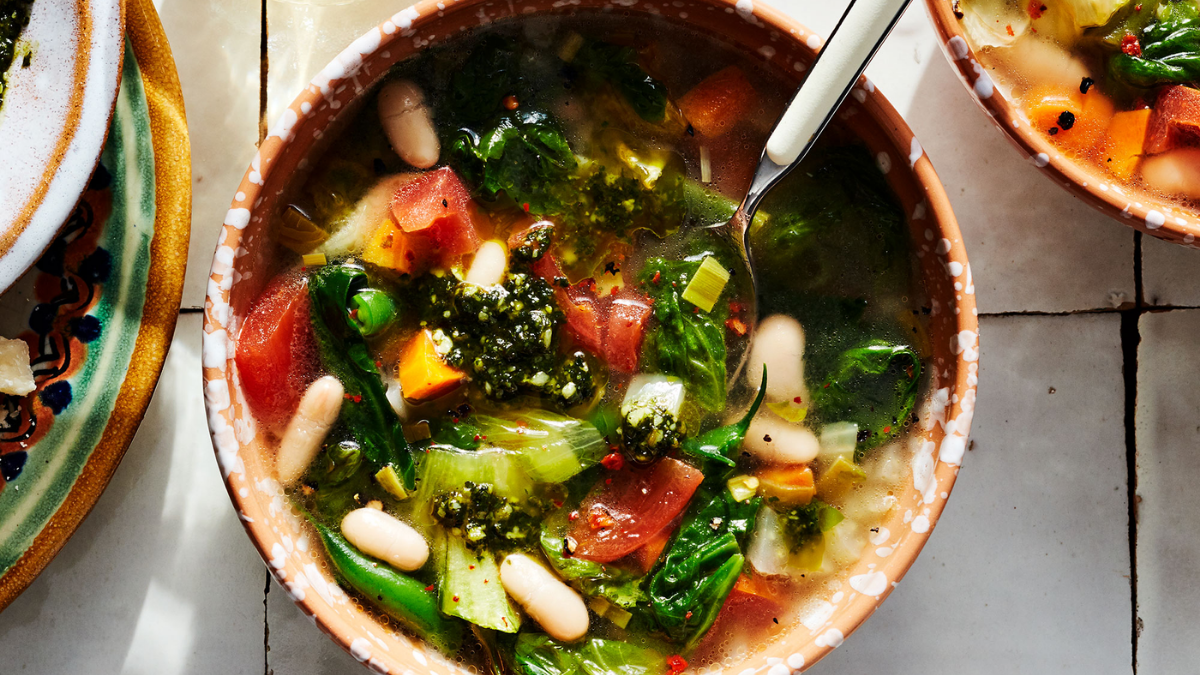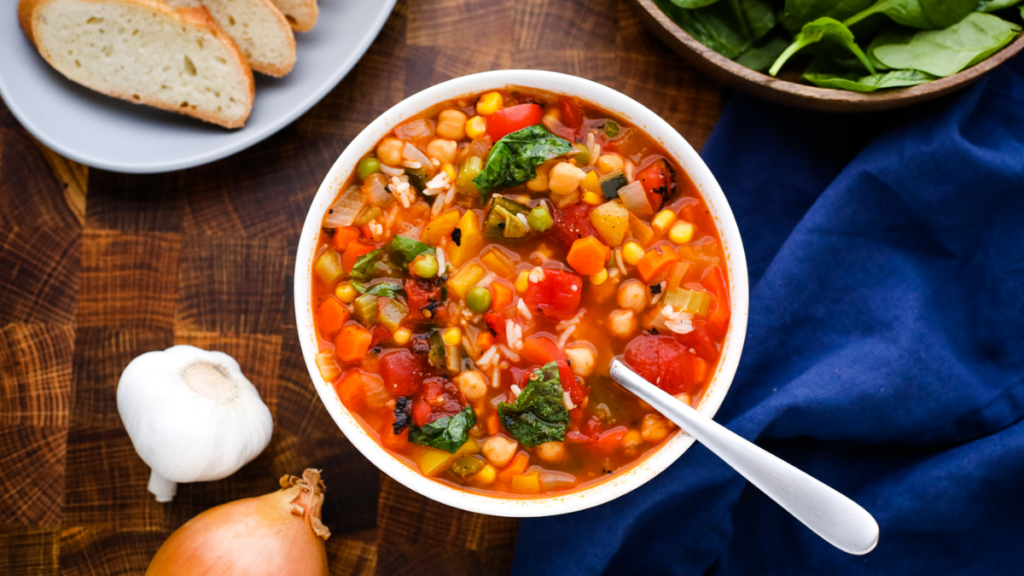It’s packed with robust vegetables that are naturally low in calories and sodium while high in fiber and minerals. It’s a Zero Smart Points soup if you follow Weight Watchers (which I’ve never done and don’t know anything about). A complete freebie. If you’re curious about the nutritional breakdown, there are online calculators you may use to fill in the recipe data.
How to Make Weight Loss Vegetable Soup?
In an oiled stockpot, cook the celery and onion until softened. Cook until the garlic is aromatic. Sauté the cabbage, peppers, carrots, green beans, and mushrooms until the veggies soften slightly. Add the vegetable broth, diced tomatoes, herbs, and spices.
Cook until the broccoli, zucchini, and lemon juice are crisp-tender, then remove from the heat. After that, serve the vegetable soup and enjoy it.
I’m afraid that if you made this healthy vegetable soup recipe in the CrockPot, everything would turn to mush. If time is a concern, I would make this on the stove when you have it and then reheat it with the bowlful for dinner or lunch during the week.
If you want to add more protein, edamame or a can of beans like garbanzo, cannellini, or kidney works well. It won’t be zero points, but it will still be highly healthy, low-cal, and low-fat. This veggie soup is a terrific way to de-clutter your produce drawer. Enjoy experimenting with the vegetables and herbs you have on hand.
Although the ingredient list is lengthy, go ahead if you don’t have anything, don’t like something, or want to substitute something different.
Ingredients
- Three tablespoons of extra virgin olive oil
- 2 cups peeled and chopped sweet Vidalia or yellow onion (about one large onion)
- 1 cup celery, tiny chopped (about two stalks)
- Four peeled and finely chopped garlic cloves
- 4 cups thinly sliced green cabbage (approximately 1/4 to 1/2 head, depending on size)
- One seeded, trimmed, and chopped medium/large red bell pepper
- One seeded, trimmed, and chopped medium/large yellow or orange bell pepper
- 1 cup peeled, trimmed, and thinly sliced carrots (approximately 1 1/2 large carrots)
- 1 cup trimmed green beans (1-inch chunks) (I prefer fresh, but frozen may be substituted)
- 1 cup mushrooms, sliced (baby portobello, white, or your favorite)
- low-sodium vegetable broth, 64 ounces (8 cups)
- one small diced tomato can (15 oz) (I use low-sodium)
- 1 1/2 cups edamame or one 15-ounce can of garbanzo beans, cannellini beans, or lentils
- drained and washed kidney beans; optional (I use low-sodium beans)
- three bay leaves
- One teaspoon of cumin powder
- One teaspoon oregano, dry
- One teaspoon thyme, dry
- 1/2 teaspoon rosemary, dry
- an optional sprinkle of cayenne pepper to taste
- 2–3 tablespoons salt (to taste)
- One teaspoon of freshly ground black pepper, or to taste
- broccoli florets, 3 cups
- 2 cups tiny sliced zucchini (about 1 1/2 large zucchini)
- Optional: 1 to 2 teaspoons lemon juice (brightens up the flavor)
Instructions
- Add the oil, onion, and celery to a large Dutch oven or stockpot and cook over medium-high heat for about 7 minutes or until veggies soften. Stir occasionally.
- Sauté for another 1 to 2 minutes with the garlic. Stir occasionally.
- Sauté for another 5 minutes, or until the cabbage, peppers, carrots, green beans, and mushrooms soften. Stir occasionally.
- Bring the vegetable broth to a boil, along with the chopped tomatoes, optional beans or edamame, bay leaves, cumin, oregano, thyme, rosemary, optional cayenne, salt, and pepper. Allow 5 minutes for the mixture to boil gradually.
- Boil for 3 to 5 minutes, or until the broccoli and zucchini are crisp-tender, adding the optional lemon juice. Take out the bay leaves.
- Taste the soup and season with more salt, pepper, or herbs as desired. The amount of salt used depends on the vegetable broth’s saltiness, the canned tomatoes, optional beans, and personal desire. Suppose the general liquid level in the soup is lower than you desire, and you prefer more broth. In that case, you can add a cup or two of water at any moment during the cooking process, keeping in mind that you can permanently alter the salt and flavor levels.
Is Vegetable Soup Beneficial to Weight Loss?
Soups are perfectly nutritious when made at home and are an excellent weight-loss dish. Not only chicken but also vegetable soups are beneficial to weight loss. Whether you call it vegetable soup or stew, these flavorful broths are packed with good nutrients for your general health and well-being. It helps with weight loss and digestion, protects against stomach abnormalities, strengthens bones, and improves heart function. Vegetable soup is tasty, nutritious, and complete! Because it’s full and low in calories, it’s ideal for weight loss.
Most pre-made soups are rich in sodium unless otherwise stated. Whether they’re canned, boxed, or served at a restaurant makes no difference. While the extra sodium will not cause fat gain, it will cause water weight to rise, according to Natker. Spinach and other leafy green vegetables such as kale, lettuce, and others are good for burning belly fat and are nutritious. There have been several research on the fat-burning qualities of spinach, and the incredibly healthy vegetable has come out on top in this category.
What is the Best Way to Create a Healthy Vegetable Soup at Home?
In the picture, chop all vegetables (carrot, cabbage, french beans, onion, and garlic) into small pieces. Combine two tablespoons of cornstarch (corn flour) in a small bowl. Three tablespoons of water, adequately combined. Heat 1/2 tablespoon oil or butter in a large, heavy-bottomed stockpot over medium heat. Soups made with vegetables and broth may be high in nutrients, including vitamins, minerals, and fiber, while low in calories and fat. Choose a broth with reduced sodium (vegetables, chicken, and beef are easily found at the market).
You can also manufacture your stock; prepare a double batch and freeze half for later use to save time. To acquire the creamy consistency you want, utilize starchy vegetables, and potatoes and butternut squash are excellent thickeners. Soup with Clear Vegetables Broccoli contains phytochemicals that aid fat reduction in the body, high-quality fiber, and various health-promoting minerals and vitamins. Carrots are one of the most low-calorie veggies you can eat to lose weight.
Is it Healthy to Eat Boiled Vegetable Soup?
Soups made with vegetables, if correctly prepared, can still be a good source of vitamins and other elements. Here are some suggestions for retaining the most vitamin content in soups made with veggies. Answer: Some vitamin loss is unavoidable in all meal preparation, including cooking. Vegetable soups can still be an excellent source of vitamins and other nutrients if adequately cooked. Many nutrients disintegrate in the cooking water and are washed away.
However, those that are heat stable remain in the soup, and you’ll consume them along with the beverages. Vegetable-based soups, in particular, are an excellent nutritional choice because they combine a high nutrient density with a low energy density, meaning we obtain a lot of essential elements like vitamins and minerals for a small number of calories.
Is it Possible to Lose Weight by Eating Pureed Soup?
Soup diets aren’t long-term weight loss treatments because they only last 5 to 10 days. Furthermore, significant and rapid weight loss can lower your metabolism, making it more challenging to maintain weight loss. Cutting 500 calories per day leads to a 1-pound weight loss in roughly a week, which is the speed at which the American Dietetic Association recommends losing weight.
The amount of calories you can save by eating soup solely is determined by what you eat today and the sorts of soup you begin to eat. The good news is that if you choose your ingredients carefully, you can ensure that your soup has more nutrients for fewer calories than most other meals. Soup has been found in studies to help people lose weight, maintain their weight goals, and reduce their risk of obesity.
When Making Soup, Why do You Sweat the Vegetables?
Sweating vegetables is a method of softening and extracting flavors from vegetables by gradually heating them. Instead of browning or caramelizing the veggies, the objective is for their mellow scents to blend with the rest of the dish without overpowering it. As a result, sautéing enhances the completed dish’s flavor and color. Sweating is the release of flavors through moisture and low temperatures. Fat is only used to store the non-volatile tastes as they are released from the onion in this situation.
Sweating vegetables is a method of softening and extracting flavors from vegetables by gradually heating them. Instead of browning or caramelizing the veggies, the objective is for their mellow scents to blend with the rest of the dish without overpowering it. Stir the vegetables often and keep an eye out for any indications of browning. The vegetables will soften in five to ten minutes. If there are onions in the mix, you’ll know it’s done when they’re transparent.
Conclusion
This easy low-carb vegetable soup recipe will hit the spot whether you’re searching for a weight loss soup or something to warm you up this winter! It’s naturally keto-friendly, paleo-friendly, vegan-friendly, and overall healthful, regardless of your eating habits. This recipe is for you if you want to learn how to create a vegetable soup that is incredibly easy to make, uses everyday items, and takes less than 30 minutes.

